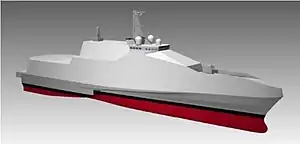 HSMVO design concept | |
| Class overview | |
|---|---|
| Name | Future Multi Purpose Trimaran concept |
| Builders | Acquisition, Technology & Logistics Agency (Designers) |
| Operators | |
| General characteristics | |
| Type | Littoral combat ship |
| Displacement | 1,500 tons |
| Length | 92.0 m (301 ft 10 in) |
| Beam | 21.0 m (68 ft 11 in) |
| Draft | 4.0 m (13 ft 1 in) |
| Propulsion |
|
| Speed | 35+ knots |
| Range | 3500 nautical miles at 15 knots |
| Boats & landing craft carried |
|
| Complement | 50 |
| Electronic warfare & decoys | 4 x Mark 36 SRBOC |
| Armament |
|
| Aircraft carried |
|
The Future Multi Purpose Trimaran concept (also known as HSMVO (High Speed Multi-hull Vessel Optimization) trimaran vessel concept) is a concept design of a future naval ship for the Japan Maritime Self-Defense Force.
Development
The Japanese Ministry of Defense held in interest in the trimaran design and conducted research on it as far back as 2011.[1]
On March 4, 2014, it was announced that Japan and US will jointly research on a LCS-style warship under the Mutual Defense Assistance Act.[2] The joint research is conducted by the Acquisition, Technology & Logistics Agency (ATLA) and the Naval Surface Warfare Center Carderock Division of the US Navy.[3][4]
In 2017, ATLA unveiled the trimaran warship concept model in a Japanese defense trade-show called MAST Asia 2017. According to Navy Recognition, the project is set to end in 2018 and the JMSDF would ultimately decide whether to adopt the concept for development or not.[4]
Design
The HSMVO design concept is based on the Independence-class littoral combat ship (LCS). As such it adopts the distinctive trimaran hull design and modular mission capabilities. Much like the Independence class, the HSMVO will be constructed out of aluminum. However, there are some differences between the HSMVO and Independence-class due to the Japanese requirements of the ship. The concept is stated to measure 92 meters in length, 21 meters in width, 4 meters in draft and displace 1,500 tons, making it smaller than both the Independence-class and Freedom-class littoral combat ships. It also has a maximum speed of over 35 knots and a range of 3500 nautical miles at 15 knots, making it slower and possessing a smaller range than either littoral combat ships. The HSMVO lacks anti-submarine warfare (ASW) and surface warfare (SuW) capabilities found on the LCS but is capable of performing humanitarian aid and disaster relief (HADR), which the LCS is not designed to do.[4]
Equipment

The concept possesses an OTO Melara 76 mm naval gun, one Phalanx CIWS above the helicopter hangar, two remote controlled weapon station slightly behind the bridge, four Mark 36 SRBOC behind the mast, one AgustaWestland AW101 for mine countermeasure or transportation, an overhead boom crane to launch and recover UUVs (located at the stern), three active ride control systems that significantly reduce pitch and roll motions (located at the main hull), and a multi-mission bay of an area of over 730 square meters. It is propelled by three diesel engines and three water jets.[4][5]
The mission capabilities of the concept includes mine countermeasure (MCM), HADR, and offshore patrol/special ops. Likewise, each configuration will consist of different weapons, equipment, and supplies.[4]
Mine countermeasure configuration consists of the following:
- 16× 4 meter MCM UUVs
- 2× 40 feet containers for the UUVs and their control units
- 2× 11 meter MCM USVs
- 1× VTOL UAV
- 1× airborne MCM helicopter
HADR configuration consists of the following:
- 7× 40 feet containers for supplies
- 2× RHIBs
- 1x transport helicopter
Offshore patrol/special ops configuration consists of the following:
See also
References
- ↑ "三胴船に働く波浪外力に関する研究" (PDF). Japan Ministry of Defense. 2011. Retrieved 31 January 2019.
- ↑ Fabey, Michael (8 March 2014). "U.S. To Help Japan Develop Littoral Warship". Aviation Week. Retrieved 31 January 2019.
- ↑ Y. Miyauchi, S. Matsumoto, K. Suzuki, K. Harada (2015). "Research on Future Trimaran (US-JAPAN Co-operative Research)" (PDF). Japan Ministry of Defense. Retrieved 31 January 2019.
{{cite web}}: CS1 maint: multiple names: authors list (link) - 1 2 3 4 5 "MAST Asia 2017: Japan's ATLA Unveils Future Multi Purpose Trimaran Concept". Navy Recognition. 13 June 2017. Retrieved 31 January 2019.
- ↑ "MAST Asia 2017, Tokyo, Japan – Day 3: ATLA & Japan's Defence Technology". DefenseWebTV. 14 June 2017. Retrieved 3 February 2019 – via You Tube.